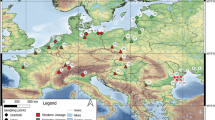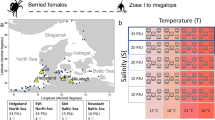Summary
We investigate how body size of two coexisting Daphnia species varies among 7 lakes that represent a gradient of predation risk. The two species segregate vertically in stratified lakes; D. galeata mendotae is typically smaller and more eplimnetic than D. pulicaria. The extent of vertical habitat partitioning, however, varies seasonally within and among lakes in apparent response to predation intensity by epilimnetic planktivorous fishes. Daphnia pulicaria uses the epilimnion at low levels of fish predation but is restricted to the hypolimnion under high fish predation, whereas D. galaeta mendotae always utilizes the epilimnion. The species display contrasting patterns of genetic variation in neonate size and size at maturity. D. pulicaria is larger in lakes with higher fish and Chaoborus densities whereas D. galeata mendotae is smaller. This contrast in body size in lakes with high predation is associated with greater habitat segregation in those lakes. In lakes with low predation risk, the two species are similar in body size at birth and maturity.
Similar content being viewed by others
References
Burton RS (1986) Evolutionary consequences of restricted gene flow among populations of the copepod Tigriopus californicus. Bull Mar Sci 39: 526–535
Burton RS, Swisher SG (1984) Population structure of the intertidal copepod Tigriopus californicus as revealed by field manipulation of allele frequencies. Oecologia 65:108–111
Goulden CE, Hornig LL (1980) Population oscillations and energy reserves in planktonic Cladocera and their consequences to competition. Proc Nat Acad Sci 77:1716–1720
Goulden CE, Comotto RM, Hendrickson Jr JA, Henry LL, Johnson KL (1982) Procedures and recommendations for the culture and use of Daphnia in bioassay studies. In: Aquatic toxicology and hazard assessment, 5th Conference Amer. Soc. Testing Mater., Philadelphia, pp 148–169
Hairston Jr NG (1983) The causes and consequences of sex-specific mortality in a freshwater copepod. Limnol Oceanogr 28:935–947
Hall DJ, Werner EE (1977) Seasonal distribution and abundance of fishes in the littoral zone of a Michigan Lake. Trans Am Fish Soc 106:545–555
Holt RD (1987) Population dynamics and evolutionary processes: the manifold roles of habitat selection. Evolut Ecol 1:331–347
Janson K (1983) Selection and migration in two distinct phenotypes of Littorina saxatilis in Sweden. Oecologia 59:58–61
Janson K (1987) Allozyme and shell variation in two marine snails (Littorina, Prosobranchia) with different dispersal abilities. Biol J Linn Soc 30:247–256
Kerfoot WC (1975) The divergence of adjacent populations. Ecology 56: 1298–1313
Kerfoot WC (1977) Competition in cladoceran communities: The cost of evolving defenses against copepod predation. Ecology 58:303–313
Kerfoot WC, DeMott WR, DeAngelis DL (1985) Interactions among cladocerans: food limitation and exploitative competition. Arch Hydrobiol Beih Ergebn Limnol 21:431–451
Lane PA (1975) The dynamics of aquatic systems: A comparative study of the structure of four zooplankton communities. Ecol Monogr 45:307–336
Leibold MA (1988) Habitat structure and species interactions in plankton communities of stratified lakes. Ph.D. thesis, Michigan State University
Leibold MA (1989) Resource edibility and the effects of predators and productivity on the outcome of trophic interactions. Am Nat 134:922–949
Leibold MA (1990) Resources and predation can affect the vertical distribution of zooplankton. Limnol Oceanogr 35:938–944
Leibold MA (1991) Trophic interactions and habitat segregation between competing Daphnia species. Oecologia (in press)
Mittelbach GG (1981) Foraging efficiency and body size: a study of optimal diet and habitat use by bluegills. Ecology 62:1370–1386
Mittelbach GG (1984) Predation and resource partitioning in two sunfishes (Centrarchidae). Ecology 65:499–513
O'Brien WJ (1979) The predator-prey interaction of planktivorous fish and zooplankton. Am Sci 67:572–581
Osenberg CW, Werner EH, Mittelbach GG, Hall DJ (1988) Growth patterns in bluegill (Lepomis macrochirus) and pumpkinseed (L. gibbosus) sunfish: Environmental variation and the importance of ontogenetic nich shifts. Can J Fish Aquat Sci 45:17–26
Schemske DW (1984) Population structure and local selection in Impatiens pallida (Balsaminaceae). A selfing annual. Evolution 38:817–832
Tappa DW (1965) The dynamics of the association of six limnetic species of Daphnia in Aziscoos Lake, Maine. Ecol Monogr 35:395–423
Tessier AJ, Consolatti N (1989) Variation in offspring size in Daphnia and consequences to individual fitness. Oikos 56:269–276
Tessier AJ, Goulden CE (1987) Cladoceran juvenile growth. Limnol Oceanogr 32:680–686
Tessier AJ, Welser J (1991) Cladoceran assemblages, seasonal succession and the importance of a hypolimnetic refuge. Fresh-water Biology in press
Threlkeld ST (1979) The midsummer dynamics of two Daphnia species in Wintergreen Lake, Michigan. Ecology 60:165–179
Threlkeld ST (1980) Habitat selection and population growth of two cladocerans in seasonal environments. In: Kerfoot WC (ed) Evolution and ecology of zooplankton communities, University Press of New England, Hanover, pp 346–357
Turkington R, Harper JL (1979) The growth, distribution and neighbor relationships of Trifolium repens in a permanent pasture. IV. Fine scale biotic differentiation. J Ecol 67:245–254
Werner EE, Hall DJ, Laughlin DR, Wagner DJ, Wilsmann LA, Funk FC (1977) Habitat partitioning in a freshwater fish community. J Fish Res Bd Can 34:360–370
Werner EE, Hall DJ (1988) Ontogenetic habitat shifts in bluegill: The foraging rate-predation risk trade-off. Ecology 69:1352–1366
Werner EE, Mittelbach GG, Hall DJ, Gilliam JF (1983) Experimental tests of optimal habitat use in fish: role of relative habitat profitability. Ecology 64:1525–1539
Woltereck R (1932) Races, associations and stratification of pelagic daphnids in some lakes of Wisconsin and other regions of the United States and Canada. Trans Wisconsin Acad Sci Arts Lett 27:487–522
Wright D, Shapiro J (1990) Refuge availability: a key to understanding the summer disappearance of Daphnia. Freshw Biol 24:43–62
Zaret TM (1980) Predation and freshwater communities. Yale University Press, New Haven, CT
Author information
Authors and Affiliations
Additional information
Authorship order alphabetical
Rights and permissions
About this article
Cite this article
Leibold, M., Tessier, A.J. Contrasting patterns of body size for Daphnia species that segregate by habitat. Oecologia 86, 342–348 (1991). https://doi.org/10.1007/BF00317599
Received:
Accepted:
Issue Date:
DOI: https://doi.org/10.1007/BF00317599




